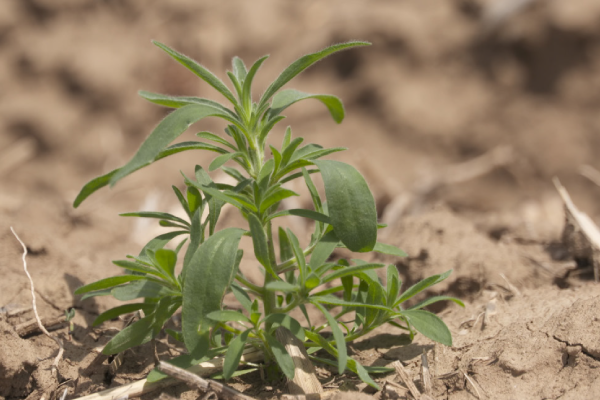ENLIST HERBICIDE OPTIONS
By Brian Hefty
If 2020 is your first year planting Enlist E3 soybeans, you are in for a treat, as weed control options abound.
Here is our suggested plan for herbicides.
PRE-EMERGE
As we always say, pre-emerge herbicides are essential if you want top yields while reducing the risk of weed resistance issues. Plus, when you use a good pre program, you may be able to save yourself one post-emerge application, which is worth a lot, and any post spray you make will work better, due to dramatically reduced weed pressure. Our top recommendation is the 3 Pre Program, which we lay out on pages ?? and ?? in this edition of the Ag PhD Insider.
BURNDOWN
If you are in no-till or strip-till, you will likely need a spring burndown. While we never recommend 2,4-D in the burndown in front of other soybeans, unless you are spraying at least 2 weeks before planting, you can safely use 2,4-D anytime you want early in the season on Enlist E3 soybeans. Just add Enlist One (the new 2,4-D choline) to the 3 Pre Program or a wide variety of other soybean herbicides. While Enlist One is labeled pre or post, regular 2,4-D is NOT labeled for use in soybeans at all, other than well in advance of planting.
EARLY POST
You can certainly use a variety of residual herbicides early post in Enlist soybeans, just like you can for any soybean trait. We love the Group 15’s (Outlook, Warrant, Dual, Zidua, etc.) and Flexstar, as all have decent suppression on many resistant weeds, as well as good soil activity for 1 to 2 months. Check the labels, but you may want to tankmix these products or others with Enlist One if you need to control weeds that have already emerged.
POST-EMERGE
We have been experimenting with many different use rates when it comes to tankmixing Liberty or Roundup with Enlist One. Here’s what we’ve learned so far. First, we absolutely love putting Liberty together with Enlist One, as our people refer to that combo as liquid fire. It knocks down weeds quickly and effectively. At this time, a reduced rate of Enlist One is not labeled in combination with Liberty. You are supposed to use a full rate, but what we used on our farm this summer worked well when we varied the rate. th tried many different rate combinations with the tankmix, and our conclusion is we would encourage you to use a full rate of Liberty (at least 32 ounces per acre) all the time. In my opinion, Liberty plus Enlist One is superior to dicamba on kochia. The number one weed in our region farmers worry whether or not Enlist One will control it, is kochia. Yes, dicamba is a little better on kochia than 2,4-D, but in Enlist crops, you can also spray Liberty, either by itself or tankmixed with Enlist One.

Many Midwestern farmers are considering using a combination of Liberty and Enlist One to effectively control tough weeds like kochia.
One last comment I want to leave you with in terms of the Enlist E3 soybeans is about yield. In our multi-state research, we have found this trait to be pretty much on par with Roundup Ready 2 Xtend in terms of yield, and in most cases, it is priced well below Xtend. However, we strongly encourage you to pick varieties that have the defensive traits you need. We saw issues with all trait platforms this year. In normal years, I look at soybean plots with yields in the 50’s to 70’s, but this year it was more like 20’s to 60’s. There was a huge disparity due to the heavy disease pressure, late planting, excess rainfall, and other environmental factors.
Enlist One herbicide is the “new” 2,4-D for use on Enlist crops. Since you may not have used this product before, I wanted to share with you some of the most important truths, rather than any misconceptions you may have based on what you know about “old” 2,4-D. Also, when spraying Enlist E3 soybeans, you can also use Roundup (glyphosate), Liberty (glufosinate), or any conventional soybean herbicide, which is why we expect a huge percent of U.S. soybean acres to go to Enlist E3 this year.
- We have been using Enlist One on our farm for 5 years now, including well before it was labeled. While soybeans are the most sensitive plant to dicamba, they are actually about 5 to 10 times more tolerant to 2,4-D. The most sensitive plant to 2,4-D is cotton, and we have been the largest cotton farmers in the state of South Dakota for several years. Granted, our cotton plantation consists of about 20 square feet, but still, it has been great for testing the drift and volatility of Enlist One. I am happy to report we have sprayed as close as 30 inches from cotton and still have seen absolutely zero movement out of the Enlist One both on our Field Day site near cotton and in our fields.
- Regardless of whether you spray Liberty, Enlist One, Roundup, or some combination of these herbicides post-emerge in Enlist crops, our recommendation is still to use a great residual program pre-emerge. You may save yourself a post-emerge trip when you use a pre, and you will almost always see a yield gain. Plus, by using other modes of action pre-emerge, you will reduce the chances for weed resistance.
- While a drift retardant (DRA or drift reduction agent) is required with dicamba in most cases, it’s not with Enlist One. However, we still recommend the use of a water conditioner like Correx, and make sure you follow the label guidelines for buffers and sensitive crops.
